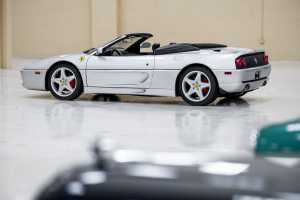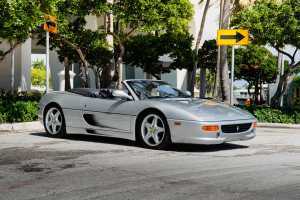For a classic car to transition into a true collectable, it must meet a diverse set of criteria. The manufacturer must be very highly regarded, as must the designer. It should be powerful, beautiful, built in limited numbers and, ideally, have a direct link to motor racing. Finally, it must have the ‘X Factor’, the element that stirs human emotions.
This may be nurtured through famous owners, having a starring role in a blockbuster movie or video game, or even, in times past, by appearing on a poster or a music video. In recent years, the mark of whether a classic model has transitioned to the level of collectable seems to be whether an owner pays a great deal of money to have one ‘enhanced’ as a top-quality restomod.
The Ferrari F355 ticks pretty much every box. It has the prancing horse on the bonnet, and the design is acknowledged as one of Pininfarina’s best from the 1990s complete with pop-up headlamps. It’s a great driver’s car, offers a Berlinetta, targa and spider options and there are ultra-rare Fiorano handling packs and gated manual gearboxes for people who want something very special. Plus, it has appeared in hundreds of movies and TV shows including The Fast and the Furious, Free Guy and Transformers: Rise of the Beasts.
The model also has a compelling creation narrative. The F355 was the car that Luca di Montezemolo launched to fight off the challenge of the Honda NSX, a job that arguably it achieved in spades. The Ferrari came with a new 3.5-litre V8 engine with five valves per cylinder – hence the 355 designation – with a new engine management system and titanium con rods that could rev to 8,500rpm. It produced 380bhp, pushing the car to 62mph from static in 4.7 seconds and to a top speed of 183mph and was the world’s most powerful production car at launch.
But the car wasn’t just fast, it was usable too. Motronic engine management made the car perform well at low speeds, ideal for cruising around town, and the gearbox gained a heat exchanger to warm the oil and aid cold changing. Gear selection was already good, thanks to connecting rods that replaced the cables of the old 348 and, from 1997, Ferrari offered an F1-style paddle shift gearbox linked to an automated single clutch.

Courtesy of RM Auctions
Promoted as a piece of racing technology for the road, the reality wasn’t so great, and three quarters of those sold had the traditional gated manual ’box. Other driver aids such as hydraulic power steering and coil springs over gas-filled shock absorbers front and rear make it very easy to live with. For those who wanted more power still, the F355 Challenge racing car was launched in 1995, some of which have been converted for road use.
Externally, although the F355 has big, curving bucket air intakes instead of side strakes, the pointed nose, pop-up headlamps and flat rear deck show a clear lineage back to the 348, the 328 and even the 512/Testarossa and 308.
Proportionally, the car works in all three guises, as a Berlinetta coupe, a targa and a convertible Spider, and inside it combines and analogue feel with switches and dials that are a big improvement over earlier cars that were often accused of raiding the Fiat parts bin.
Most importantly, it is a car very much of the era – the mid-1990s – that is growing most in collectability terms. Hagerty has long known that owners aged between 40 and 60 are the powerhouses of the classic/collectable market, combining peak earning capacity with the space and time to make the most of any automotive purchase.
This generation look to the 1980s to the early 2000s for their heroes, and the F355 was built smack bang in the middle of that range. The final marker that the F355’s time happened this summer when DRVN released the reimagined F355 Evoluto first at the Goodwood Festival of Speed, then at Monterey Car Week . With a carbon-fused chassis and body by Callum, a totally revitalised interior and engine & mechanical upgrades overseen by technical director Amjad Ali, who used to work in the same role for Gunther Werks, this car that DRVN describe as ‘Peak Analogue’ was almost universally acclaimed by the motoring press.

Courtesy of RM Auctions
Given all these positives, it’s not surprising that values of the F355 have increased significantly over the past few years: for the standard Berlinetta, Hagerty Price Guide ‘Excellent’ condition values have almost quadrupled since 2019, easily outpacing its 348 and 360 stablemates.
The signs are that the F355 is also attractive to younger buyers than for similar cars: although it’s not exactly a Millennial favourite yet, 18 percent of owners are under 40 years-of-age, higher than for the Porsche 911 (993), the Ferrari Testarossa and 360, and nearly three times more than for the 550 Maranello.
Also, the percentage of younger F355 owners has fluctuated by just two points in the past five years, compared to the 550 which changed by seven points, and the 360 by five. The values of these two models also changed most during the post-covid boom but then stagnated, compared to the F355 which continued upwards.
So, what’s the outlook? A steady and consistent price increase, younger buyers and growing press interest all point towards future growth. As with any collectable car, matching numbers, low mileage, a great history and no accident damage will be essential to maintain top value.
Manual gearboxes are definitely more desirable that the F1 paddles, the latter taking a significant hit on value, sometimes up to a 25% reduction. The ultra-rare Fiorano handling pack – reported to have been fitted to just 14 UK cars – will always be in demand from collectors, as will the Challenge cars that can still be raced in the growing historic scene or – if properly registered – on the road.

Courtesy of RM Auctions
But even for a standard car, prices seem to still offer a lot of car for the money: the Hagerty Price Guide ‘Excellent’ value is under £80,000 for all three body types, under half the price of a Porsche 911 (993) Turbo, another car considered a sweet-spot model from the same era. I can’t see those prices remaining static for long.
See more at hagerty.co.uk
